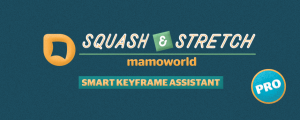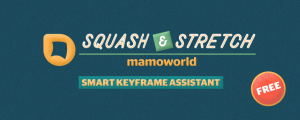Section 3
Focus & Motion
This is a secret weapon that you only have in motion graphics. You can move things around – and that movement can control the focus. What attracts your attention in this clip?
Although everything you learned in the hierarchy section clearly indicates that the text at the bottom is less important, a little bit of motion makes you forget all that and immediately notice it.
Why Brains Focus on Movement
Why does movement have such a huge impact on our focus? Well, paying attention to movement was absolutely crucial to the survival of our species. What does a lion leaping out of the bushes have in common with the rocks that suddenly fall in your path? The answer is they both move fast, and you have to deal with them immediately if you want to survive. Perhaps you just spotted some berries for your next meal, but these berries aren’t moving and will still be there in ten minutes. It makes a lot more sense to deal with the lion or the falling rocks first.
Motion Contrast
As with color, motion also only works if it has enough contrast. During an earthquake, everything is moving; you feel overwhelmed, and don’t know what to watch out for. If everything is moving in your design, the same thing happens. And if everything is moving except for one thing, guess what you’re focusing on:
This focus on things that are not moving is particularly strong if everything else is moving in a consistent way.
Motion Contrast in Nature
Some animals also know about motion contrast. Typically, animals don’t move at all when they hide from their enemy. But there are some animals that try to move consistently with the background as a form of camouflage. The Leach’s Spider Crab, for example, hides between algae in the water. Those algae swing back and forth with the current, so in order to look like the algae around it, the crab actively imitates this swinging movement. Stick insects can also move pretty fast when they fear they’ve been discovered, but their normal movements are very slow and kind of shaky, imitating leaves moving with the wind.
What can we learn from this? What you want the viewer to focus on should move significantly more – or at least in a different way – than everything else in your scene.
In this scene from the Squash & Stretch Pro promo video, the trees in the background move quite a lot. But although it’s not the usual tree movement we know from reality, the fact that all trees are moving in more or less the same monotonous way tells our brains that this is a decorative, background kind of movement. If just a single tree were moving, we would certainly notice it. All the trees are moving, but the movement of the orange box is much less regular, making it less predictable and thus more lifelike. So, the viewer still focuses on the box and isn’t distracted by the movement of the trees.

Create animations in no time with Squash & Stretch, featuring a vast range of ready to use behaviors, carefully handcrafted by professionals and controlled by an intelligent system. This Pro version includes over 60 extra behaviors and 350 extra sound effects and can also be extended with additional behavior bundles.

Create animations with Squash & Stretch in no time with a collection of ready to use behaviors, carefully handcrafted by professionals and controlled by an intelligent system – ensuring your animations come to life without starting from scratch each time.
Join our newsletter for updates on this book and more great stuff we create!